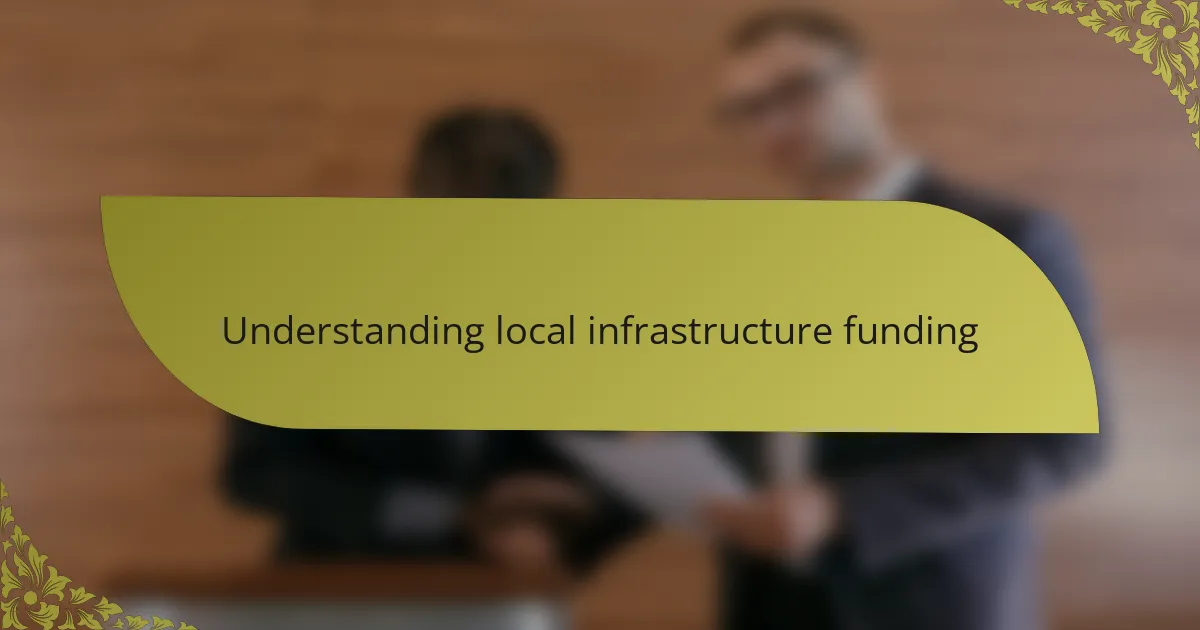Key takeaways
- Local infrastructure funding involves contributions from federal, state, and local sources, emphasizing the need for community involvement and advocacy.
- Advocacy empowers citizens to address local concerns, influences policy decisions, and leads to impactful changes in community infrastructure.
- Key players such as local government officials and community organizations play crucial roles in advocating for and securing infrastructure funding.
- Improved infrastructure has profound effects on community safety, economic growth, and social cohesion, enhancing the overall quality of life.

Understanding local infrastructure funding
Local infrastructure funding is crucial for the development and maintenance of our communities. I often witness the impact of inadequate roads, bridges, and public transportation on daily life. It’s frustrating to see how neglected infrastructure can affect everything from local businesses to emergency services. I remember a time when a pothole in my neighborhood delayed an ambulance response, emphasizing just how vital timely funding is for our safety and quality of life.
Understanding where our funding comes from and how it’s allocated can feel overwhelming. However, it’s essential to engage with local leaders and understand the funding processes. Here are some key points to consider:
- Federal and State Contributions: Many infrastructure projects rely on funding from both federal and state governments, often through grants or special programs.
- Local Taxes: Municipalities often fund infrastructure through property taxes, sales taxes, or specific levies designated for maintenance and improvement.
- Community Involvement: Local advocacy and input can significantly influence funding decisions, ensuring that projects meet community needs.
- Project Prioritization: Not all projects receive equal funding; understanding local priorities helps in advocating for the most critical needs.
- Public-Private Partnerships: Collaboration between government entities and private organizations can create innovative solutions to funding shortfalls.
By grasping these elements, I became more empowered to advocate for infrastructure funding that truly benefits our community.

Importance of advocacy in politics
Advocacy plays a critical role in shaping effective policies, especially in areas like local infrastructure. In my experience, voicing community concerns can elevate the importance of projects that may otherwise go unnoticed by decision-makers. I remember attending a town hall meeting where passionate residents shared their stories, which ultimately highlighted the pressing need for a new bridge. It was a powerful reminder that advocacy isn’t just about policies; it’s about real lives affected by those decisions.
Here are a few key reasons why advocacy is essential in politics:
- Empowerment of Citizens: By advocating for their needs, citizens become active participants in democracy.
- Visibility of Issues: Advocacy brings attention to local concerns that might be overlooked, leading to better funding and support.
- Community Building: Working together towards a common cause fosters a sense of unity and shared purpose among residents.
- Influencing Policy Decisions: Engaging with policymakers can sway opinions and lead to more informed decision-making.
- Creating Lasting Change: Successful advocacy can lead to transformative changes that improve lives for generations.

Overview of Louisiana government structure
Louisiana’s government structure is quite unique and reflects its diverse culture and history. The state operates under a mixed form of government that includes both executive and legislative branches, along with a distinct judiciary. It’s fascinating to observe how this structure allows for strong local governance while still adhering to state mandates.
At the executive level, the Governor of Louisiana holds significant power, overseeing state departments and agencies. I recall a time when I attended a meeting where the Governor spoke passionately about the importance of infrastructure, which really drove home how crucial leadership is in advocating for necessary changes. Meanwhile, the legislative branch, made up of the House of Representatives and the Senate, plays a vital role in developing policies and funding allocations. This interplay between branches can sometimes feel complex, especially when advocating for local needs, but it’s also where community voices can truly make an impact.
Judicially, Louisiana has courts structured to ensure justice, but they can also set precedents that affect infrastructure funding decisions. It’s interesting how legal rulings can have ripple effects on civic projects. I’ve observed firsthand how court cases around land use can delay vital infrastructure developments, reminding me of the interconnectedness of our governing bodies. This complexity may seem daunting, but it’s essential for ensuring that every voice, including ours, is considered in shaping our community’s future.

Key players in Louisiana infrastructure
In Louisiana, several key players significantly impact infrastructure funding and development. Local government officials, particularly mayors and parish presidents, play pivotal roles as they often spearhead initiatives and advocate for necessary projects. From my experience, interacting with these officials has shown me that their passion for improving community conditions drives much of the funding conversations.
Community organizations also serve as vital advocates, translating the needs of residents into actionable proposals. I vividly remember attending a town hall meeting where a local group presented compelling arguments for better road maintenance. Their determination was inspiring and highlighted how grassroots advocacy can influence infrastructure funding.
- Local government officials (mayors, parish presidents)
- State legislators advocating for infrastructure
- Community organizations and non-profits
- Business leaders supporting infrastructure projects
- Federal agencies and their funding programs

My personal experiences in advocacy
My experience in advocating for local infrastructure funding has been transformative. I remember attending community meetings where the need for better roads and bridges was clear. It wasn’t just about asphalt and concrete; it was about connecting families and business opportunities.
During our campaign, we gathered stories from residents that highlighted the impact of dilapidated infrastructure. Listening to those heart-wrenching accounts made me realize how essential it was to keep pushing for funding. It became personal for me, feeling their frustrations and hopes.
Here’s a quick comparison of the approaches we took in advocacy:
| Approach | Description |
|---|---|
| Community Engagement | We held town hall meetings to hear directly from residents. |
| Data-Driven Advocacy | We presented statistics on traffic accidents and economic loss due to poor infrastructure. |
| Coalition Building | Partnered with local businesses and organizations to amplify our voice. |

Strategies for effective advocacy
When advocating for local infrastructure funding, developing a clear message is crucial. I remember spending long nights drafting a single page that outlined both the need for improvements and the positive impact they would have on our community. As I honed my argument, I felt a growing sense of responsibility to represent the voices of residents who often felt overlooked in these discussions.
In addition to crafting a compelling message, building coalitions can amplify your efforts. Connecting with local groups who share your vision can create a powerful network of support. These partnerships not only provide additional resources but also instill confidence in decision-makers.
- Clearly define the issue and your proposed solution.
- Gather data and personal stories to illustrate the community impact.
- Connect with local organizations and stakeholders to broaden support.
- Attend community meetings and actively engage in conversations with residents.
- Be persistent but respectful in your outreach to government officials.

Impact of funding on local communities
When local infrastructure funding gets allocated, the ripple effects on communities are profound. I witnessed firsthand how freshly paved roads improved safety and connectivity in neighborhoods, fostering a sense of pride. I remember attending a community meeting where residents shared their relief and excitement over a new playground; it wasn’t just about the equipment, but about creating a safe space for children to play and families to gather.
It’s not just about buildings or roads; it’s about enhancing the quality of life. I’ve seen local businesses thrive because of improved accessibility, allowing them to attract more customers. These enhancements bolster community spirit, and it’s honestly uplifting to see neighbors coming together to celebrate what their advocacy has accomplished.
| Key Aspect | Impact on Community |
|---|---|
| Infrastructure Improvement | Enhances safety and accessibility |
| Economic Growth | Increases business opportunities and job creation |
| Community Engagement | Fosters a sense of belonging and collaboration |